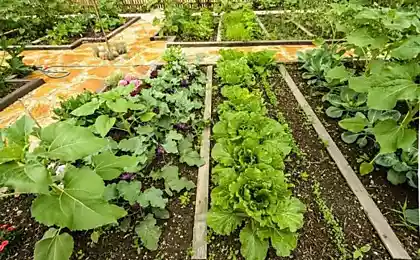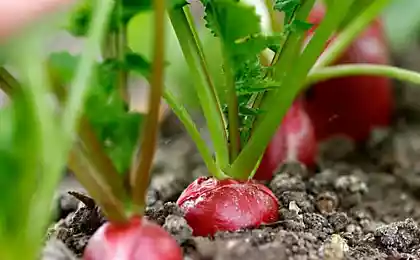430
Incredibly useful radish

Radish is one of the roots having the highest nutritional value. It is used in salads or in main dishes. Belongs to the cabbage family (Brassica). In Chinese culture, the root along with cabbage and soybean curd tofu is a healthy food. A popular Chinese proverb says that those who eat radish and drinking hot tea, do not leave the doctors work. This vegetable has spread from mainland China many centuries ago and now widely cultivated in different parts of the world. The scientific name of radish is Raphanus sativus. Radishes come in different shapes, sizes and colors. Different varieties of this vegetable and seasonal maturation is Generally considered that there are four main types of radishes — summer, autumn, winter and spring. But agricultural producers klassificeret them by shapes, colors and sizes. Sometimes even black and white radish. Found this vegetable is round and oblong.
The sharp taste of the radish gives it contained "isothiocyanate" connection. The taste is fairly mild (white radish) and very sharp — in a round red and other pigmented his grades. Green radish is also edible and is eaten in some parts of the world.
Daikon radish (Daikon) is a Japanese variety of radish. It grows during the winter months and has an oblong white root vegetables.
Black Spanish radish is very spicy and has a more intense flavor than the white variety.
Green radish comes from the Northern part of China. Its peel is characterized by green color, the same as leaves, but the lower, the lighter the color gets to the tip it becomes white. The flesh of the vegetable has beautiful jade green color, sweet and not too sharp.
Watermelon radishes are so named because the color of her flesh is like the flesh colors of watermelon. It is characterized by a not too spicy taste and some sweetness and reminds that white varieties of radish.
If you leave radishes in the garden, and after it is time to harvest the roots, all of its varieties bloom small flowers which ripen edible pods. Green radish ("rat's tail") is a variety grown only for its long pods. The pods combine the mild flavor of the radishes and the sharpness of spices.
The benefits of radish for health
Since ancient times, Chinese believe that eating radish and other Brassica vegetables — cabbage, cauliflower, Chinese cabbage — has a beneficial effect on health.
Radish is one of the low calorie root vegetables. Fresh root contains only 16 calories per 100 grams. The radish is a good source of antioxidants, electrolytes, minerals, vitamins and dietary fiber.
Radish, like other cruciferous vegetables and cabbage families, isothiocyanate contains the antioxidant compound sulforaphane. The results of the research found that sulforaphane plays a role in cancers of the prostate, breast, colon, and ovaries, suppressing the growth of cancer cells and exerting a cytotoxic effect on cancer cells.
Fresh roots of radish are a good source of vitamin C (100 grams contains 15 milligrams of vitamin C, which is approximately 25% of the recommended daily norms of consumption). Vitamin C is a powerful water-soluble antioxidant needed by the body for synthesis of collagen. It helps the body rid itself of harmful free radicals, prevents cancer, inhibits inflammation and helps boost immunity.
Radishes also contain appreciable amounts of folic acid, vitamin B6, Riboflavin, thiamin and minerals such as iron, magnesium, copper and calcium.
In addition, it contains many phytochemicals (phytochemicals) such as indole, which is characterized by a detoxifying impact, as well as zeaxanthin, lutein and beta-carotene, which are flavonoid antioxidants. Their total antioxidant activity, measured in the ability to absorb oxygen radicals (ORAC index) is 1736 micromol (µmol) TE per 100 grams.
HealthAliciousNess resource includes information about the radishes those powers to prevent disease, to which he is entitled. It is believed that it boosts immunity, prevents heart disease, slows aging, DNA repair and protects them. Radishes softens for cardiovascular diseases and hypertension, contributes to the prevention of Alzheimer's disease, osteoporosis and stroke.
It is also believed that radish helps in various diseases — whooping cough, cancer, arthritis, kidney stones, dyspepsia (indigestion), constipation, intestinal parasites and gallstones. But it is only those ideas that have developed about the radishes and not necessarily that they are true. In any case, the treatment can be prescribed only by a qualified doctor, and any, even the most useful products should be used with caution.
Selecting and storing radishes
Give preference to fresh, strong and dense roots. Radish greens also should be fresh and green, no patches of yellow and shriveled leaves. Avoid the roots of radishes with cracks and cuts on the surface. Pay attention to changes in texture and color. Yellow indicates that radishes have long stored. If the roots are dented and soft, the pulp will likely not be crisp.
At home, separate the greens from the roots, because it pulls from the roots nutrients. Then rinse the radish in clean water to remove dust and dirt. Store in plastic bag in the refrigerator. In this case, the radishes will remain fresh up to a week. Before eating radishes is undesirable peel, because it largely contains the antioxidant allyl, an isothiocyanate gives the radish "pepper" spicy aftertaste.
Caution
The radish can contain zabojnye substances (goitrogen — stimulate the formation of goiters substances), plant compounds that are found in plants of the families Cruciferae and Brassicaceae, including cauliflower and broccoli. Goitrogen can cause swelling of the thyroid gland and should be avoided by people with thyroid dysfunction. However, for healthy people no contraindications. However, in everything, even wholesome foods, there must be a sense of proportion.
Nutritional value
In parentheses are the percentage of the daily allowance. The nutritional value is given per 100 g of fresh raw radish (Raphanus sativus) according to information from the Ministry of agriculture of the USA, shown in the resource Nutrition And You.
General information:
the energy value is 16 kcal (1%);
carbohydrates — 3,40 gram (3%);
protein — 0.68 grams (1%);
fats — 0.10 gram ( cellulose, part of the food — 1.6 grams (4%).
Vitamins:
folic acid (vitamin B9) — 25 micrograms (6%);
nicotinic acid (vitamin B3) — 0,254 milligrams (1,5%);
pyridoxine (vitamin B6) — 0,071 mg (5,5%);
Riboflavin (vitamin B2) — 0,039 mg (3%);
vitamin a, which very much is contained in dandelion — 7 international units (IU, IU) — vitamin C — 14.8 milligrams (25%);
vitamin K, an incredibly rich source of which is sage — 1.3 micrograms (1%).
Electrolytes:
sodium 39 milligrams (2,5%);
potassium 233 milligrams (5%).
Minerals:
calcium — 25 mg (2,5%);
copper — 0,050 mg (5%);
iron — 0.34 mg (4%);
magnesium — 10 mg (2,5%);
manganese — to 0.069 milligrams (2,5%);
zinc: 0.28 milligrams (2%).
Phytonutrients:
alpha-carotene (α-carotene) — 0 micrograms;
beta-carotene (ß-carotene), which is rich in carrots — 4 micrograms;
lutein-zeaxanthin — 10 micrograms.published
P. S. And remember, only by changing their consumption — together we change the world! ©
Source: hi-news.ru
100-year-old Jia Dojan: and heaven And hell are on earth and not await us after death
That hide the depths of the ocean























